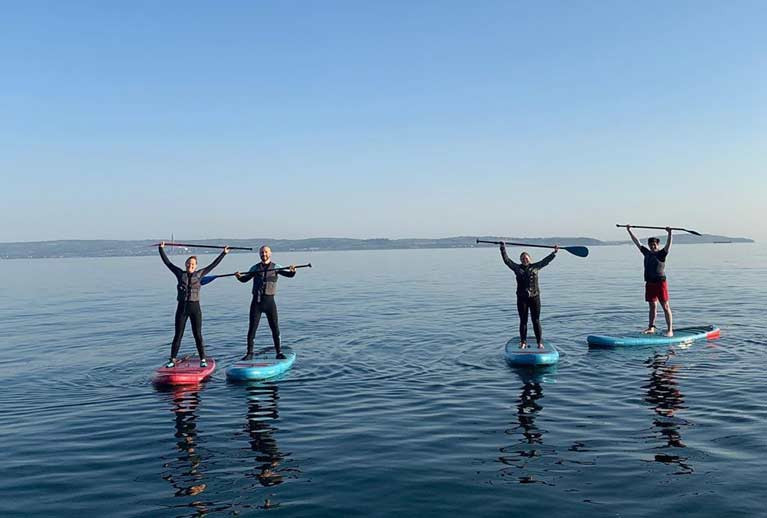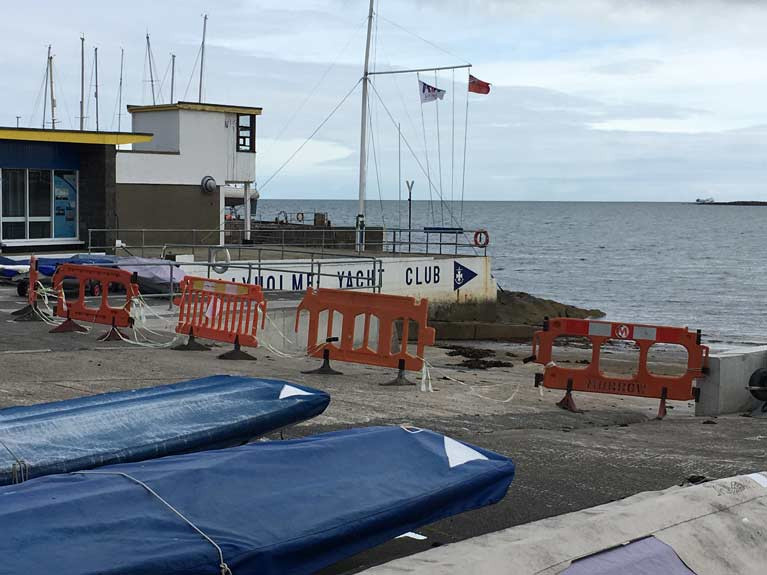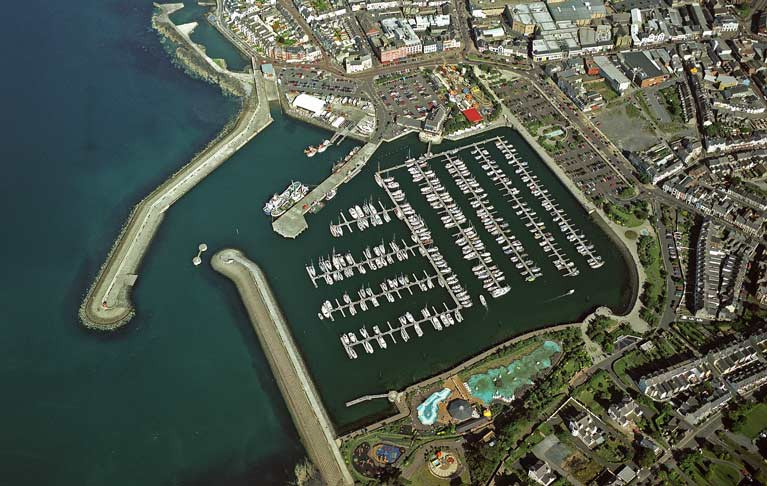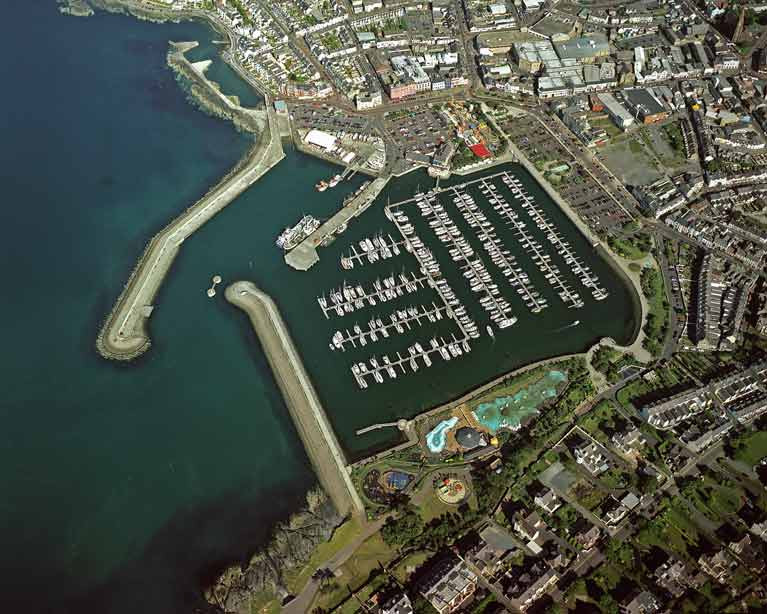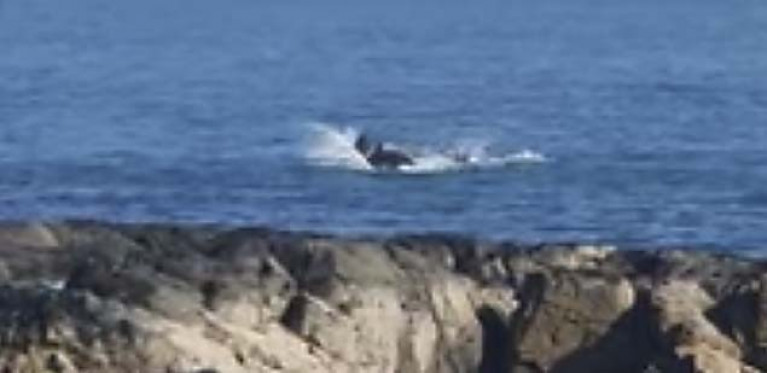Displaying items by tag: Belfast Lough
A Belfast Lough Maritime Consortium led by Artemis Technologies has won a £33 million UK Government innovation grant to develop zero emissions ferries in the city, that will revolutionise the future of maritime transport. With further investment from consortium partners, the total project investment will reach close to £60m over the next four years, creating an initial 125 research and development jobs, and leading to more than 1,000 in the region over the next 10 years.
The 13 partner syndicate - which is a mix of established and young companies, including Belfast Harbour and Bombardier, academia and local public bodies - is the only Northern Irish or maritime recipient of the UK Research and Innovation flagship Strength in Places Fund.
A spin-off from the America’s Cup sailing team, Artemis Racing, Artemis Technologies is led by double Olympic gold medallist Iain Percy OBE.
Iain said: “When we launched Artemis Technologies, we decided to base ourselves in Belfast because of the incredible aerospace and composite engineering talent available.
 efoiler propulsion system
efoiler propulsion system
“Belfast’s local expertise coupled with the city’s rich shipbuilding heritage, and our own America’s Cup yacht design experience, will ensure Belfast is the global lead in zero emissions maritime technology.
“For years, we’ve been designing low energy, high-performance solutions for some of the fastest yachts on the planet, and we will now utilise that knowledge, and along with our partners, apply it to build the world's most environmentally friendly high-speed ferries, capable of carrying up to 350 passengers.”
Iain added: “Our concept for an electric hydrofoil propulsion system is totally unique and will enable vessels of the future to operate with up to 90% less energy, and produce zero emissions during operation.
“As cities across the world seek ways to reduce pollution and ease traffic congestion, the transformative vessels to be produced right here in Belfast, will have a global role to play in delivering the connected maritime transport system of the future.
“This investment from the UKRI Strength in Places Fund is a major endorsement of what we are trying to achieve, which we strongly believe will see Northern Ireland at the centre of the revolution in water transport.”
Welcoming the announcement, First Minister Arlene Foster said: “We are all proud of Belfast’s maritime and shipbuilding heritage. However, it is even more exciting to look towards a future which can see Northern Ireland once again leading the way with world-class manufacturing and cutting-edge technology.
“I pay tribute to all those involved in the project which demonstrates so clearly the benefits of collaboration between business, academia and government at all levels. This investment can support economic growth locally, but its impact could be felt globally through solutions to more sustainable transport.”
The Belfast consortium brings together a range of established and young firms, academia and public bodies, including: Belfast Harbour, Bombardier Belfast, Northern Ireland Advanced Composites Engineering (NIACE), Creative Composites, Energia, Catalyst, Invest Northern Ireland, Ulster University, Belfast Met, Queen’s University, Belfast, Ards and North Down Borough Council, and Belfast City Council.
Joe O’Neill, Chief Executive, Belfast Harbour, said: “As we continue to develop Belfast Harbour as a key economic hub and centre for innovation, we are pleased to partner with Artemis Technologies in this cutting-edge maritime design project which keeps our city firmly on the shipbuilding map. Ambitious collaborative partnerships such as this are key enablers to help unlock groundbreaking technical innovations and this project fully aligns to Belfast Harbour’s vision to become one of the world’s greenest and best regional ports.
“Belfast Harbour is already home to a diverse range of businesses and this collaboration will only see that expand while also creating new pathways to employment and economic growth opportunities within Belfast and beyond.”
Suzanne Wylie, Chief Executive, Belfast City Council added: “This investment will help our economy recover more quickly, creating jobs and economic prosperity for the city - both key objectives of the Belfast Agenda.
“We are delighted to be working in partnership with such talented, forward thinking colleagues to build the first zero emission ferries here. Belfast has a long history of innovation and it’s hugely exciting to know that once again, we’re on the cusp of a significant engineering breakthrough – one which will position us as pioneers in advanced manufacturing, resilience and transitioning to a low carbon economy.”
Michael J Ryan CBE, Chief Operating Officer, Aerostructures, Bombardier Aviation commented: “As the largest manufacturer in Northern Ireland, Bombardier Belfast is a centre of excellence for the design, manufacture and aftermarket support of complex metallic and advanced composite aerostructures and therefore can provide a depth of experience, capability and capacity in support of Artemis Technologies.
“Bombardier Belfast is keen to expand into markets that exploit our capabilities/advanced technology and where there are synergies with novel technologies. The Artemis Technologies project, in our view, represents a credible technology path that could provide a technological ‘step-change’ to the maritime sector and passenger transportation.”
UK Research and Innovation Chief Executive, Professor Sir Mark Walport, said: "UK Research and Innovation funding through the Strength in Places Fund will bring researchers, industry and local leadership together in outstanding collaborative programmes that will catalyse regional excellence and economic growth across the UK."
Research England’s Executive Chair, David Sweeney, who leads the Strength in Places Fund, said: “UK Research and Innovation’s flagship Strength in Places Fund is distinctive in specifically targeting investment to foster the local research and innovation ecosystems that can support sustained growth.
 Iain Percy
Iain Percy
“All of these projects have the potential to deliver research and innovation that will transform activity within their target industries, in a way that is deeply rooted in local strengths and well linked to wider local economic plans.
“And, with a second wave of Strength in Places funding already in the pipeline, we look forward to broadening the reach of that impact to further projects in other areas of the country in future.”
RNLI Rescue Young Kayakers on Belfast Lough
Answering what was the Bangor Coastguard Rescue Team’s third shout of the day yesterday (Sat 20th), after a telephone call from former Lifeboat Operations Manager Kevin Byers, a volunteer RNLI crew was tasked with rescuing three kayakers in Ballyholme Bay in the vicinity of Ballymacormick Point.
RNLI said that although well equipped with wetsuits and buoyancy jackets, the youngsters had not taken into account the difficulty of paddling against an offshore breeze. The wind was forecast around 40 mph from the South.
An eyewitness said that they could see the kayakers were having difficulty returning to shore in the very strong offshore wind and struggling to make even painstakingly slow progress, and when one of them appeared to stop for a rest, they were blown back very quickly again. She also noticed that the temperature was dropping as the wind and cloud cover increased.
Fortunately, the RNLI were able to return the three teenagers safely to the beach and hand them over to the Bangor Coastguard Rescue Team.
RNLI warn that “ Kayaks and paddleboards are so light and prone to windage that fighting against an offshore breeze can be exhausting and you can quickly find yourself in difficulty. Even with the right safety equipment you can tire quickly”. They advise that it is important to remember these simple rules before you take to the water:
- Check the conditions - water and wind
- Assess your competence if things go wrong
- Make sure you have the right safety gear
- Have some means of calling for help
- Make sure you know how to signal for help if your phone or radio is out of battery or range
And to Parents, “if you are buying a paddleboard or kayak for your child, INSIST that they buy and wear the right safety gear - a LIFEjacket is called that for a reason. And if you are new to the sport, get some training.
New Crane Gives Belfast Harbour a Lift
A new £6.6M ship-to-shore container handling crane is Belfast Harbour’s largest-ever investment in a single piece of port equipment.
The installation is part of a £40M upgrade of its Victoria Terminal 3 (VT3) container terminal.
The new fully electric crane is part of a three-year investment project to significantly improve the container terminal’s safety, sustainability, efficiency and capacity, progressing Belfast Harbour’s ambition to be the best regional port in the world.
Since Belfast Harbour sources all its electricity from green energy, this new fully electric crane will also be carbon neutral.
Michael Robinson, Belfast Harbour’s Port Director, said: “As part of our £40M investment programme in VT3, this new crane will service the increasingly large container ships importing and exporting from Belfast. It is one of ten new cranes that are being installed, supporting Belfast Harbour’s SMART Port strategy to improve efficiency through new technology and further our ambition to be the best regional port in the world”.
Belfast Harbour’s real estate landholding extends to some 2000 acres, strategically located at the focal point of the city’s transport infrastructure and represents some 20% of the city area.
Declan Freeman, Managing Director of Belfast Container Terminal Limited, operators of the VT3 terminal, said: “We welcome the significant investment Belfast Harbour is making in the container terminal which will make it one of the most modern and efficient terminals in these islands. The new Liebherr ship-to-shore crane is a superb asset for the terminal and together with the investment in new automated rubber tyre gantry cranes, we are confident that operational efficiency and safety will be enhanced.”
Manufactured by Liebherr in Co. Kerry, the crane was delivered to Belfast Harbour’s D1 site (in Co. Down) in March. After a 12-week construction period, it was moved across the Victoria Channel by barge to VT3 (in Co. Antrim) in a complex 15-hour operation last weekend.
Standup Paddleboarding is Back on Belfast Lough
Another water activity on the go again under Step 1 of the Northern Ireland Executive’s plan is Standup Paddleboarding. SuphubNI is a mobile venture based in Bangor on Belfast Lough run by Iain McCarthy and he is delighted to get afloat again after the lockdown.
At the moment activities cover Dawn Patrols, Ready to Ride lessons, five-week courses and private and family sessions. Iain says, “ As we move along the 5 Step plan we will be able to offer a wider range of activities and larger group sessions”.
All kit required is provided for every class and Iain has initiated a Covid Policy to ensure the operation is in line with guidance of the government and public health guidelines.
Suphubni works closely with Bangor Harbour and keeps in constant contact by handheld VHF marine radio. The recent kind weather has been ideal for this sport.
In what will be a welcome decision by the Ballyholme Yacht Club, members will now be able to proceed, albeit slowly and patiently, towards a return to watersports.
Commodore Aidan Pounder has emailed members with the news that SportNI has specified in its Framework to guide progression towards a resumption of sport and physical recreation in Northern Ireland, that this includes swimming in open water and all forms of water - sports practised on open waterways – sailing, windsurfing, canoeing, rowing, kayaking, surfing, paddle - boarding and the use of motorised craft (in line with navigation authority guidance. He goes on to say “ I and indeed your Executive Officers fully appreciate that everyone wants to get back to some form of normality, but unfortunately, I don’t envisage this for some time. In the interim we will be embarking on a start towards this new normality with small steps, starting tomorrow (24th May) at 0900 hrs with the opening of our grounds and slipways”.
"A booking system to limit the number of sailors at the club has been implemented"
In order to make this safely workable, a booking system to limit the number of sailors at the club has been implemented within this link for 24th May, Monday 25th May and Tuesday 26th May. And within this document is the ability to book for other watersports sessions such as sea swimming, paddleboarding and windsurfing at specific times on Monday 25th and Wednesday 27th May.
In particular, sailing will be available for small groups in sessions, up to 12 can book per session, to be split between North and South parks and slipways. This is required in accordance with NI Executive guidelines. There will be no safety cover for the session
The Commodore continued “I must reiterate the guidance from the RYANI, who are correctly advocating patience to allow the necessary actions as required to be taken so that the environment is as safe as it can be for our Members, Staff and visitors”. And concludes by saying that “The Return to Water Team and Executive Committee are working hard for you and I hope that you can be patient with us as we move forward”.
Bangor Marina To Reopen to Boat Owners on Tuesday
A good news story tonight for berth holders in Bangor Marina on Belfast Lough. In a Notice to Mariners issued this evening (Monday 18th May), Harbour Master Kevin Baird has stated that it is planned to open Bangor Marina tomorrow, Tuesday 19th May at 1200hrs BST.
This follows today’s statement by First Minister Arlene Foster that the following is allowed:-
Outdoor activity where social distancing can occur, and people do not touch shared hard surfaces can also proceed’
It goes on to state that as the safety of berth holders, contractors, and the Marina team is absolutely paramount; to keep everyone safe and protect life, strict safety protocols will be followed. As previously mentioned in afloat.ie on 16th May, measures have been put into place to allow Bangor Marina to open safely. These protocols will be revised over time along the pathway to recovery.
Social distancing - practice and maintain 2m social distancing at all times. Please pass port to port on the pontoons, using the finger berths to get that extra clearance distance.
Access to the Marina is by fob only – priority must be given to those coming up the ramp and exiting the Marina. Please hold at the white lines and observe social distancing at all times.
To comply with Government guidance on not touching shared hard surfaces:-
Toilets & the Marina Reception will remain closed.
- Trolleys will not be available.
- Water Taps – Do not use the water taps.
- Do not stay overnight on board your vessel.
- Refuelling is by prior appointment only. Please adhere to the strict social distancing rules in place and ensure good hygiene practices including the use of gloves whilst handling fuel pump equipment.
It goes on to advise action to be taken if you or any member of your household is presenting with any symptoms of Covid-19 and what the quarantine requirements are.
It is stressed that other local harbours and marinas may not be open. And most importantly, the Notice states “We would strongly recommend that you do not undertake sea voyages at this time”.
The Notice to Mariners will be reviewed daily and the protocol will be updated when the time is right.
Mr Baird goes on to say on behalf of Boatfolk Marinas Limited “Your efforts, patience, and commitment to staying away from your boat throughout this unprecedented period have undoubtedly helped save lives and protected the NHS; and we thank you for that".
Coastworker Displacement Tug Arrives in Bangor Harbour
Bangor Marina on Belfast Lough may be closed but the Harbour is certainly not out of bounds to commercial traffic and the 120-ton displacement tug Coastworker arrived yesterday afternoon. She will tow the modular barge currently berthed alongside the commercial pier to the Clyde.
The barge was on charter to ABCO, a Lisburn based specialist marine civil engineering service working throughout Ireland, the UK and continental Europe. It was used in their dredging operation of the River Lagan.
It was demobilised at Bangor Harbour as part of a long-standing working relationship with ABCO.
Harbour Master Kevin Baird points out that “not only do we offer a sheltered and safe haven but provide essential services like fuel to Lifeboats, Police, Border Force, Royal Navy, Commercial Fishing Vessels and Pilot Boats.
The Coastworker is 19.5m long with two Caterpillar engines, a maximum speed of 11 knots and a bollard pull of 13 ton.
Is this the Silver Lining for Bangor Marina?
For those boat owners in Bangor Marina on Belfast Lough itching to have access to their boats and get afloat again, the latest communication from Dean & Reddyhoff and Quay Marinas will give some hope. They say that “we’re starting to hear whispers of positive news coming from the UK government. This means we can start firmly looking towards the future”.
Since closure on Tuesday 24th March, staff have been busy looking after the boats and working hard to keep the facilities and equipment in peak condition so that things are shipshape for the return to boating.
As soon as the lockdown is lifted, there will obviously be a huge demand for boat owners to undertake maintenance and repairs. The team at Bangor Marina understand the concerns of berth holders and have put in place a number of additional safety protocols that will allow authorised contractors to work on boats from Monday 4th May 2020.
Dean & Reddyhoff and Quay Marinas have said “ We’re acutely aware of how frustrating the current position is, with boat owners desperately wanting to gain access to their pride and joy. Please rest assured that we will be monitoring government directives on leisure boat owners closely so that we can reunite you with your boats just as soon as is safe to do so. In the meantime, we are continually checking and making sure everything is okay with all boats at our marinas, and we will continue to keep you updated”.
Bangor Coastguard Rescue Team Assists Youths in Inflatable Canoe
Bangor Coastguard Rescue Team on Belfast Lough was tasked on Friday afternoon after a member of the public contacted the Belfast Coastguard Operations Centre raising concern about an inflatable canoe with two people on board.
The team arrived on scene at the 'Long Hole' to meet the two young men and gave them advice.
The Long Hole is a disused harbour near the Eisenhower Pier, which practically drains out at low tide but fills to about two metres at high tide.
 The Long Hole
The Long Hole
They had just taken ownership of the canoe and with the weather being sunny and warm, they thought it would be a good opportunity to try out their new purchase.
It was pointed out that they had little experience and had no lifesaving equipment. The rescue team thanks CGOC Belfast and to the member of the public for reporting it.
In this present COVID-19 situation whatever the activity on the water, there is the additional concern that if something goes wrong, however unlikely that may seem, there is the potential that it will put further and avoidable pressure on the emergency services.
Dolphin & Porpoise Sightings on Belfast Lough
People may not be able to go to sea at present due to the Government restrictions but dolphins and porpoises clearly can’t read and so we are seeing reports of their activity in Belfast Lough.
Recent sightings include about eight dolphins (likely bottlenose) off Orlock Point near Groomsport on the North Down coast, heading north-west, and of harbour porpoises at Black Head opposite on the Co. Antrim coast.
You can watch the dolphins in the video below
A dozen porpoises were sighted in calm conditions, feeding, travelling and resting and heading northeast.
And had boat owners been able to go down the pontoons at Bangor Marina last Saturday they might have had a treat. The duty berthing master watched a mother otter and two pups playing on a pontoon.





























